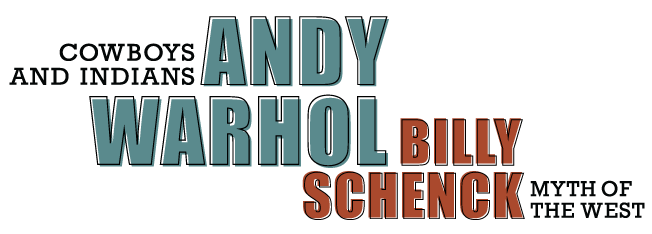 Andy Warhol: Cowboys and Indians and Billy Schenck: Myth of the West
Andy Warhol: Cowboys and Indians and Billy Schenck: Myth of the West
January 19 - March 19, 2022
Andy Warhol was the undisputed leader of American pop art, a movement characterized by artists’ use of household items, advertising images, other “low” art forms, and commercial printing techniques in an effort to democratize art. Warhol had a tremendous gift for understanding the myths of the Baby Boomer generation. His ability to identify images that expressed the essence of the Boomers can be seen in his early work in the 1960s, including Soup Cans and the Elvis Presley series. The Cowboys and Indians series, Warhol’s last major project before he passed in 1987, pays tribute to the archetypal symbols of a popular, romanticized version of the American West. Distilling an ocean of imagery down to ten prints, Warhol challenged the meaning of playing “Cowboys and Indians” in American media culture.
Warhol initially selected 14 images to make trial proofs, but contractual arrangements led him to change his selection. This was the only time Warhol tested more than the ten images he included in a final edition. Andy Warhol: Cowboys and Indians will feature the full portfolio plus four additional trial prints. These images combine iconic portraits and totemic images, traditional and new Western representation using modern reproduction methods. Now iconic itself, the Cowboys and Indians series is a time capsule of America in the 1980s, when we had a cowboy in the White House. Only 250 copies of the portfolio were printed.
Despite the beliefs of many in the art community that mainstream modern art is the direct antithesis of what has come to be known as Western art, Warhol’s Cowboys and Indians suite links the two art genres in a new aesthetic. Rejecting the abstractness of modernism and embracing a more traditional representational approach, Warhol and the pop art movement established a link to Western art and its use of icons and, in so doing, helped reestablish respectability for representational art among contemporary collectors.
 Billy Schenck was one of a handful of artists in the 1970s inspired by Warhol to apply pop art ideology and techniques to images of the American West. A founder of the Western pop movement, Schenck combined influences from his many artist-heroes in the pop movement—including Roy Lichtenstein—in his exploration of every aspect of the West’s potent iconography. In his early work, Schenck found inspiration and image sources in Western paintings and movie stills, but being a genuine cowboy himself, he increasingly turned to his personal photographs for material. With his signature reductivist style, Schenck transformed traditional Western images from a realist’s replica of detail into flat, sharply defined, simplified areas of color and stylized patterns. This retrospective of the artist’s work showcases 26 pieces in his distinctive style.
Billy Schenck was one of a handful of artists in the 1970s inspired by Warhol to apply pop art ideology and techniques to images of the American West. A founder of the Western pop movement, Schenck combined influences from his many artist-heroes in the pop movement—including Roy Lichtenstein—in his exploration of every aspect of the West’s potent iconography. In his early work, Schenck found inspiration and image sources in Western paintings and movie stills, but being a genuine cowboy himself, he increasingly turned to his personal photographs for material. With his signature reductivist style, Schenck transformed traditional Western images from a realist’s replica of detail into flat, sharply defined, simplified areas of color and stylized patterns. This retrospective of the artist’s work showcases 26 pieces in his distinctive style.
Press Release: Andy Warhol and Billy Schenck Western Pop Art to Exhibit at SUMA
Related Programs
Curator Discussion: Billy Schenck
Thursday, February 17, 2022, 6-7 p.m.
Shalee Cooper, Director + Curator of Modern West Fine Art, and Jessica Kinsey, Executive Director of SUMA, will talk with Billy Schenck about his concurrent exhibitions Schenck's Utah: A Land Less Traveled and Billy Schenck: Myth of the West. Join us on Zoom or in-person at the Charles Hunter Room at the Hunter Conference Center where we will be broadcasting the conversation live.
Audio guides
Our audio tours highlight exhibitions currently on display in the museum offering an alternative to reading wall text.
Virtual Tours
Virtual Tours Explore the museum through thematic tours highlighting our exhibitions and permanent collections.

